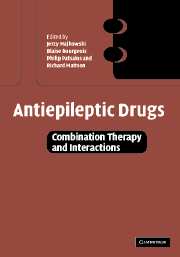Book contents
- Frontmatter
- Contents
- List of contributors
- Foreword
- Foreword
- Acknowledgements
- Part I Introduction
- Part II Pharmacokinetic interactions
- Part III Pharmacodynamic interactions
- Part IV Drug interactions in specific patient populations and special conditions
- 14 Antiepileptic drug interactions in children
- 15 Antiepileptic drug interactions in the elderly
- 16 Antiepileptic drug interactions in pregnancy
- 17 Antiepileptic drug interactions in handicapped and mentally retarded patients
- 18 Antiepileptic drugs and sex steroids
- 19 Antiepileptic drug interactions in patients requiring psychiatric drug treatment
- 20 Antiepileptic drugs in non-epileptic health conditions: possible interactions
- 21 Drug monitoring in combination therapy
- 22 Cognitive side-effects due to antiepileptic drug combinations and interactions
- Part V Conclusions and future perspectives
- Index
21 - Drug monitoring in combination therapy
from Part IV - Drug interactions in specific patient populations and special conditions
Published online by Cambridge University Press: 07 September 2009
- Frontmatter
- Contents
- List of contributors
- Foreword
- Foreword
- Acknowledgements
- Part I Introduction
- Part II Pharmacokinetic interactions
- Part III Pharmacodynamic interactions
- Part IV Drug interactions in specific patient populations and special conditions
- 14 Antiepileptic drug interactions in children
- 15 Antiepileptic drug interactions in the elderly
- 16 Antiepileptic drug interactions in pregnancy
- 17 Antiepileptic drug interactions in handicapped and mentally retarded patients
- 18 Antiepileptic drugs and sex steroids
- 19 Antiepileptic drug interactions in patients requiring psychiatric drug treatment
- 20 Antiepileptic drugs in non-epileptic health conditions: possible interactions
- 21 Drug monitoring in combination therapy
- 22 Cognitive side-effects due to antiepileptic drug combinations and interactions
- Part V Conclusions and future perspectives
- Index
Summary
Introduction
In 1978 Penry remarked ‘The clinical management of epilepsy has improved dramatically in the past decade through the determination of serum antiepileptic drug (AED) concentrations’ (Penry, 1978). The recommendations for undertaking therapeutic drug monitoring of AEDs in serum are based on clinical experience and on a number of studies demonstrating a correlation between serum concentrations of AEDs on the one hand, and seizure frequency and dose-dependent adverse effects on the other hand. Such a correlation, which is more significant for some AEDs than for others, has been found for the majority of the established AEDs. As for new AEDs, with the exception of vigabatrin, analogous data are increasingly becoming available (Johannessen et al., 2003).
The relationship between serum concentration, seizure frequency and side effects gives the therapeutic range or target range (Table 21.1). In this range, an AED can be considered to be associated with no dose-dependent side effects in the majority of the patients in whom it is effective. Thus the range provides guide values which give a more rapid identification of a patient's individual therapeutic range, which reflects the patient's clinical susceptibility to seizures, seizure type, etc. However, despite a good deal of anecdotal testimony, surprisingly little has been published demonstrating the benefits of anticonvulsant therapeutic drug monitoring in epileptic populations (Eadie, 1995).
Keywords
- Type
- Chapter
- Information
- Antiepileptic DrugsCombination Therapy and Interactions, pp. 392 - 402Publisher: Cambridge University PressPrint publication year: 2005

